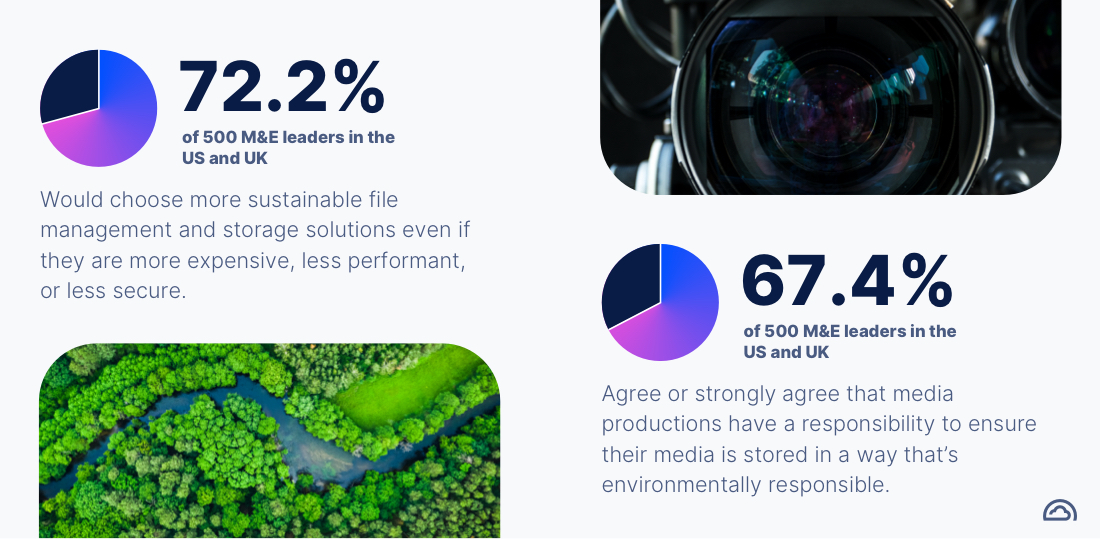
A Storj survey of 500 media and entertainment (M&E) leaders in the US and UK found that 84% of respondents feel they are aware of the carbon costs created by media storage. The survey also found that 70% believe that storing media in the cloud allows their organization to operate more sustainability. (see full report - no wall)

In many ways, they are correct. Storing data in a data center that uses renewable energy and is efficient with the storage is indeed a lower carbon footprint than on-premises storage. However, there are some problems with traditional cloud storage. Cloud storage is necessary for today’s media workflows, but awareness of new alternatives is critical to help reduce carbon emissions from media and entertainment.
This blog will educate you on the additional ways that M&E can reduce the carbon impact of production, as well as provide insights from media tech veterans. Because the real opportunity to significantly reduce the carbon impact of a production is not about what takes place on set, but rather where you put your data.
Data is more damaging than a film crew.
“We’ve seen a lot of focus on the reduction of carbon emissions on set, but everything from that onward regarding sustainability has taken second priority,” explains Tom Dunning, CEO and Co-Founder of Ad Signal. “I hope people become aware of the carbon impact both of the cloud and the online processing, the rushes, the archives, the streaming—all that.”
Dunning adds that the M&E industry might focus on the visible aspects of sustainability but, as an example, “If you eat vegan everyday, cycle to work everyday, and then when you go home and upload a minute of video to YouTube, you’ve undone all that carbon savings.”
It is true that the energy costs of data compute and storage are climbing exponentially. Data storage today represents 2X the carbon impact of the global airline industry and is continually growing. Additionally, a recent study reveals that the video streaming industry accounts for 4% of global carbon emissions, this is also 2X the aviation industry. The cloud industry needs to look at ways to reduce carbon emissions beyond renewable energy.
The cloud can do more to extend the life of hard drives as the mining and manufacturing of just 1TB of a traditional HDD results in 20kg of carbon. One 1TB SSD results in 160kg of carbon. Traditional cloud providers replace servers before the end of their life out of fear of data loss, but there are new ways to avoid this to extend the life of hardware and reduce carbon.
Additionally, the media and entertainment industry can do better about the amount of data being stored. Reducing unneeded duplicates and choosing backup storage that achieves redundancy without replication is critical.
The CEO of Ad Signal says that he hopes “people will become more aware of the carbon impact of both the cloud and online increased processing.”
Opportunities for carbon reduction.
Eric Tang, co-founder of Livepeer, had some interesting insights when asked about carbon reduction opportunities. “Everywhere in the production workflow there are opportunities,” he says. “On set is a sure way, but also in the way that you shift your data around. Also, where you run your compute, your data centers, how these data centers are operated, what kind of energy source is being used, or are you using shared capacity?”
Eric mentions that the good thing today is that there is more transparent information on “how much energy is being used by these cloud vendors and it’s a lot.”
“It’s interesting for solutions like Storj and Livepeer where we are really pushing forward on a shared model,” he adds. “We’re taking advantage of existing hardware and capacity that’s already deployed out there. We’re repurposing it and it’s kinda similar to recycling.”
Watch the full video for more insights on M&E tech leaders’ thoughts on sustainability and cloud storage.
Cloud storage that significantly reduces carbon impact.
As mentioned, the cloud is not as “green” as you may think. Traditional cloud architectures copy and store data in multiple regional data centers for global availability, which puts a 2-6x multiplier on data growth. But are the data servers running at full capacity? According to studies from the NRDC and IBM, most servers operate at only 12-18% of capacity, implying that there is a huge reservoir of already manufactured and powered, but severely underutilized, storage capacity.
Distributed cloud architecture is a smarter, more sustainable approach to reducing the carbon impact of media. Storage and compute capacity comes from existing hardware
and disks already spinning, so almost no additional energy is needed. Also, through the distributed cloud, there is no requirement for new energy-hungry data centers to be built. Watch the short video to learn how the distributed cloud helps reduce carbon emissions from media.
“When it comes to carbon reduction, the cloud has a really big play,” says Mathew Sobkowicz, co-founder at MASV. “The fact that you can be in one location and upload your files, and in another location to download those files, means you no longer have to ship those physical files. With solutions like Storj and MASV, it’s a huge reduction in costs and emissions.”
Media production wants to be more sustainable.
Sixty-seven percent of Storj survey respondents “agree” or “strongly agree” that media productions have a responsibility to ensure their media is stored in a way that’s environmentally responsible.

The M&E industry wants to make a difference. 72.2% of survey respondents would choose more sustainable file management and storage solutions even if they are more expensive, less performant, or less secure.
Storj’s distributed cloud storage brings a breakthrough solution to the media and entertainment industry. By leveraging a global network of tens of thousands of storage nodes, Storj enables unparalleled collaboration and efficiency that traditional storage solutions and legacy cloud platforms simply can’t match. And the best news, it is actually less expensive than what you pay for hyperscalers like AWS.
Get more insights in the report 5 Ways the distributed cloud solves hybrid media workflow issues (no wall). To learn more about carbon reduction on the distributed cloud, visit https://www.storj.io/object-storage/reduce-carbon.

















